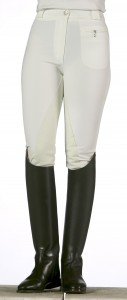Q. When I was getting ready to go to a show recently, I found that my white synthetic-blend breeches had yellowed. Is there anything I can do to get them sparkling white again?

A. Unfortunately, the combination of bleach and spandex (Lycra?), a component of many synthetic-blend breeches, can cause permanent yellowing. You may not have noticed the discoloration until after you removed the breeches from storage because the process can occur over time. However, if you did not bleach your breeches or the care label says it’s safe to bleach them, the yellowing may have resulted from a number of other causes:
Too much heat. Clothing containing nylon, for example, should only be air-dried or dried at a low temperature.
Prolonged exposure to sunlight.
Washing in an overloaded machine. This may cause loosened soil to be redeposited on garments, creating a yellowish effect.
Oxidation of protein stains. Stains that might not have been evident earlier can react chemically with oxygen in the air over time, slowly changing the color of the material.
Deposits of metals, such as iron and manganese, from your water supply. These can cause yellowish-brown stains on fabrics.





Before trying to reverse the yellowing?actually, before laundering or even buying any clothing?read the care label. This is your best precaution against many fabric calamities. For example, if an all-white garment cannot tolerate bleach, the care label will read, “Do not bleach.”
With the care label precautions in mind, try one of the following procedures to treat the type of yellowing you think occurred.
1. For yellowing caused by washer overloading, dissolve 1?4 cup powdered detergent, such as Tide?, into enough water to cover the garment. Let soak for 8-12 hours, then rewash in plenty of water.
2. If the care label says that your breeches can be bleached, add 1?2 to 3?4 cup of regular bleach to the wash water and detergent, then wash. Always be sure to use the amount of bleach recommended on the product label, and never pour full-strength bleach directly onto the garment. Instead, dilute it by pouring it into the bleach dispenser or by adding it with the detergent as the washer water is filling, before adding the clothes.
If you’re uncertain of your breeches’ bleachability and you’re sure they don’t contain Lycra, perform a colorfast test on a hidden part of the item (e.g., hem, pocket.): Add 2 teaspoons of liquid bleach?to 1?4 cup of water. Apply a drop of this solution to the hidden area.?Wait one minute. If you see no color change, it is safe to use bleach.
If the yellowing showed improvement following bleaching but was not entirely ?removed, try a bleach soak prior to another full wash: Soak the breeches for 10-15 minutes in a solution of 1?4 cup of regular liquid bleach per gallon of water. Then run them through a complete wash cycle.
3. To remove protein stains that have oxidized over time, soak the breeches in an enzyme product such as BIZ, Ultra Era? or Wisk?. Follow the directions on the product label, then rewash.
4. For yellowing caused by minerals in your water supply, try treating your breeches with a dye-remover product, such as Rit? Color Remover.
5. If all else fails, you can try to minimize the yellowing by treating the breeches with a bluing agent. Follow the directions carefully, though. Too much bluing can produce an equally undesirable grayish appearance.
Here are some general tips to keep in mind for future laundering:
Sort garments by color (dark vs. light), degree of dirtiness (muddy vs. barely worn) and linting characteristics (lint shedders?fuzzy fabrics vs. lint acceptors?smooth fabrics). Note: ?Nylon ?attracts soil and colorants. For best ?results, wash nylon garments separately from garments made of other fibers.
Treat stains with a pretreatment product (Shout?, SPRAY ‘N WASH?, Zout?).
Use the warmest water recommended on the care label.
Start the washer before adding detergent to the water. After the detergent has completely dissolved, loosely load clothes into washer.




Next time you store your breeches, clean and dry them carefully (following that care label) before placing them in a cool, dry, well-ventilated location, away from direct sunlight. Avoid storing them in plastic bags, which can encourage moisture accumulation. If you store them in a wooden container, wrap them in a clean pillowcase to protect them from the acid in the wood, which can cause brown spots on clothing.
Finally, should you have yellowing problems with breeches in the future?or any other unexpected failures in fabric performance?despite having followed the care label’s cleaning instructions to the letter and stored the breeches as I’ve recommended here, return them to the seller and demand a refund.
Charlotte Coffman is a senior extension associate in the Department of Fiber Science & Apparel Design at Cornell University in Ithaca, New York. She draws on an educational background in microbiology, medical technology and food chemistry to educate the public about textile-related issues.
This article originally appeared in the September 2008 issue of Practical Horseman magazine.










